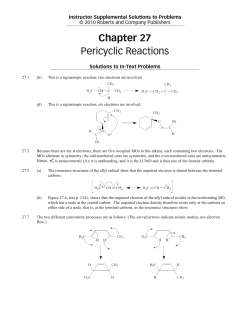
1 of 13 April 1390 Alison Flynn
1 of 13 CHM 1321 Sample Final Exam April 1390 Alison Flynn Time: 3 hours Name: ____________________________________________ Student Number: ___________________________ Notes: - Attempt all questions - The marks are given as a guide and are subject to minor changes - A Faculty-approved calculator and molecular models are permitted - When key ideas such as “resonance” are used in explanations, draw structures to prove your point - Show relative stereochemistry where applicable - Total number of pages: - Approximate number of points: 2 of 13 1. Identify the stereochemical relationship between the following molecules (enantiomers, diastereomers, constitutional isomers, same molecule, other). (4 points) a. and Cl OH Cl Relationship: _____________________ OH b. and Relationship: _____________________ c. d. OH and HO Relationship: _____________________ 2. a. Arrange the following molecules in order of increasing nucleophilic ability in an SN2 reaction. (1 point) b. Explain the difference in nucleophilic ability between B and D. (3 points) 3 of 13 3. The following reaction gives four (4) possible products. a. Draw mechanisms to account for the formation of each product. (14 points) b. Circle the major alkene product. (1 point) 4 of 13 4. Arrange the following electrophiles in order of increasing reactivity in an SN1 reaction. (1 point) a. b. Clearly explain the difference in reactivity between B and C. Your answer should include a reaction coordinate diagram. (10 points) 5 of 13 5. a. Draw a mechanism for the acid/base reaction shown below. (5 points) b. Does the equilibrium favor the starting materials or the products?(1 point) c. Explain your answer in part b. (4 points) 6. Suggest two different ways to synthesize the following alcohol from a carbonylcontaining compound. Mechanisms are not required. (5 points) 6 of 13 7. a. Draw the resonance structures for the following ether, including arrows showing the movement of electrons. (5 points) O b. Identify the major, minor, and intermediate (if applicable) structures and explain your choices. (7 points) c. Draw the resonance hybrid structure. (3 points) d. What is the physical significance of the resonance hybrid structure? (2 points) 7 of 13 8. The following reaction will not give the product shown: O LiCH3, H3O+ HO a. Explain why not by showing the reaction that would take place. (2 points) b. Suggest a solution to this problem in order to obtain the desired product. (2 points) 9. 10. Fill in the boxes with the missing reagents, starting materials, or products as required. Be sure to show relative stereochemistry where applicable. (10 points) 8 of 13 a. Give a mechanism for first step of the following reaction and the final product: (9 points) 1. BH3 2. H2O2, NaOH b. Explain the regiochemistry in the product. (2 points) c. Explain the stereochemistry in the product. (2 points) 9 of 13 11. Give the products of the following transformations. (14 points) Note: - Mechanisms are not required but part marks might be given for an incorrect answer with a reasonable mechanism. a. b. c. OsO4 d. HBr HOCH3 (solvent) e. f. g. 10 of 13 12. a. Draw a mechanism in 2D for the elimination reaction shown above, ignoring stereochemistry. (4 points) b. Draw a Newman projection of the starting material in its reactive conformation. (2 points) c. Draw the final product of this reaction with the correct stereochemistry. (2 points) 11 of 13 13. a. Give a mechanism for the following reaction. (11 points) b. Why was it important to use obtain dry ice immediately before using it in the laboratory? (2 points) c. Calculate the yield if a student began the experiment with 3.0 mL of bromobenzene (density = 1.5 g/mL, molar mass = 157 g/mol) and obtained 2.9 g of white crystals at the end of the reaction (molar mass of product = 122 g/mol). Please clearly show your calculations. (3 points) d. How could you verify that the white crystals were the desired product? (1 point) 12 of 13 14. Describe how you would separate a mixture of benzyl amine and benzophenone. Both compounds are soluble in EtOAc. (10 points) Be specific – a first year student should be able perform the separation by following your instructions. 13 of 13 15. Suggest a synthesis of the following molecule from starting materials that possess two carbons or less. (12 points) Notes: - Your answer must include a retrosynthetic analysis and a synthesis. - Mechanisms are not required.
© Copyright 2025





















